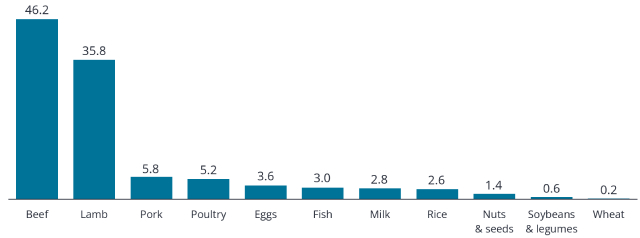Subscribe
Sign up for timely perspectives delivered to your inbox.
Portfolio manager Tal Lomnitzer highlights the key approaches to achieve sustainable agriculture, and the significant investment opportunity.

In an urgent bid to address the agriculture sector’s carbon footprint, while balancing the needs of feeding the global population, a wave of innovative solutions and technologies are quickly emerging.
With population growth showing no signs of abating, the race is on to meet the demand for food without adding to the already significant emissions footprint of the global agricultural sector.
Breakthrough solutions across the agricultural value chain are attracting significant investment, with initiatives focused on decreasing food waste, making the most of already scarce resources and advancing innovation in sustainable agriculture.
In the US alone, sustainable agriculture has attracted US$2.4 trillion in assets under management.1
The urgency to reduce emissions is laid bare by the enormity of the sector’s growing emissions profile. Emissions from global food systems equate to around one-third of the worldwide total, and of this, almost 40% comes from agricultural production. Direct emissions from cattle and dairy are collectively greater than any single country, excluding China.2
The chart depicts the number of kilograms of carbon dioxide equivalent (CO2e) needed to produce a single kilogram of food by category. While beef is incredibly emissions-intensive, this issue and others like it are being tackled by agricultural innovation and changing practices. Meanwhile, increased production of alternative proteins, greater availability of fresh produce and changing diets to reduce meat consumption are helping to address the total emissions related to food production.

Source: McKinsey & Company, Agriculture and climate change, Reducing emissions through improved farming practices. April 2020. Data: Greenhouse gas emissions from pig and chicken supply chains: A global life cycle assessment, Food and Agriculture Organization of the United Nations (FAO). Rome; Greenhouse gas emissions from ruminant supply chains: A global life cycle assessment, Food and Agriculture Organization of the United Nations (FAQ) Rome; McKinsey analysis.
Without any material changes to current practices, agricultural emissions are predicted to increase by 15-20% by 2050 due to a swelling global population and per capita growth in food consumption of between 8-12%.3
Reducing food system emissions will require change on various fronts. When it comes to agriculture specifically, optimising the animal feed mix, crop rotation strategies, regenerative farming and improving fertilising practices are just a few ways that can help.
Additionally, an explosion of new agricultural technology or ‘agtech’ innovations are already making a material difference, including:
We see a significant role for agriculture in the achievement of net zero and a great opportunity for companies that facilitate and embrace the change.
1 Farming for the Future, PWC. March 2022.
2 Agriculture and Climate Change, McKinsey.
3 The future of food and agriculture – The Food and Agriculture Organization (FAO) of the United Nations
4.Agtech market review – Global Banking and Finance Review.
Disclosures
Commodities (such as oil, metals and agricultural products) and commodity-linked securities are subject to greater volatility and risk and may not be appropriate for all investors. Commodities are speculative and may be affected by factors including market movements, economic and political developments, supply and demand disruptions, weather, disease and embargoes.
Natural resources industries can be significantly affected by changes in natural resource supply and demand, energy and commodity prices, political and economic developments, environmental incidents, energy conservation and exploration projects.
Sustainable or Environmental, Social and Governance (ESG) investing considers factors beyond traditional financial analysis. This may limit available investments and cause performance and exposures to differ from, and potentially be more concentrated in certain areas than the broader market.